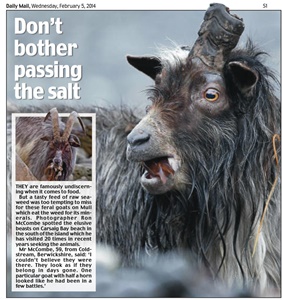 A primitive feral GOAT with half a horn looks like a mythical unicorn as it eats SEAWEED on the beach.
A primitive feral GOAT with half a horn looks like a mythical unicorn as it eats SEAWEED on the beach.
The elusive prehistoric-looking creature was snapped by photographer Ron McCombe in Carsaig on the Isle of Mull on Scotland’s west coast. The herd of primitive goats, which have huge horns and shaggy coats, are extremely hard to find and are rarely photographed.
“I have visited the beach around 20 times in the last couple of years and not seen the goats so I was delighted to spot them feeding on the beach,” said Ron, 59, from Coldstream in Scotland. “I couldn’t believe they were there. They look as if they belong in days gone by and they smell revolting. In fact I could smell them before I could see them. No one culls or manages the herd so they survive by natural selection. One particular goat with half a horn looked like he had been in a few battles.”
The goats come down to the beach area from the very steep-sided cliffs to eat the seaweed as there is a mineral deficiency in their diet.
Feral goats are not native to Britain and were brought here in Neolithic times around 4,000 years ago as domestic stock. Most British herds are thought to be the descendants of domesticated stock that was allowed to go feral when sheep replaced goats as the favoured animals of farmers in the Middle Ages.
British Feral Goats are small, with ears which stand upright, horns in both sexes and long coarse, shaggy coats. Each animal has different characteristic markings on its body and face, which make it easy to identify individuals. Annual growth rings on the horns can be used to age the goat.


